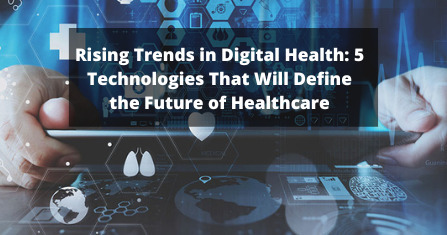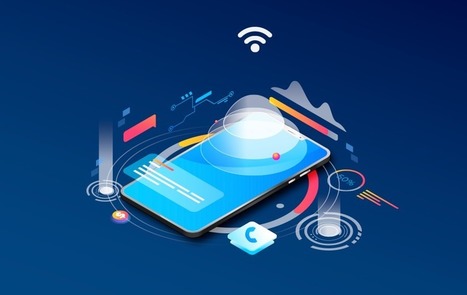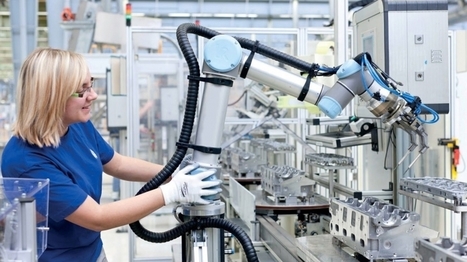Healthcare and technology go hand-in-hand. But the question on many people's minds is where are they going? Digital health trends like telemedicine, IoT devices, and virtual reality surgical training continue to attract massive investment, helping the industry improve health equity worldwide.
The World Health Organization defines health equity as "... the absence of unfair and avoidable or remediable differences in health among population groups defined socially, economically, demographically or geographically."
Put simply, health equity is all about making healthcare more accessible and affordable for everyone — and digital health trends are the driving forces behind health equity.
Of course, there are many challenges on the road to achieving this goal, with stakeholders at all levels of government involved and a myriad of social determinants of how we collect, analyze, and share health data.
Read on as we explore the five crucial digital health trends with real momentum and explain why they matter to health equity and the future of healthcare.
5 Biggest Digital Health Trends to Watch
The pandemic triggered massive disruption in the healthcare industry and pushed the sector to invest more in innovative new technology. Some of the following digital health trends gained momentum during the pandemic and are predicted to change the future of medicine:
1. TELEHEALTH
Telehealth is the use of digital communication technologies such as computers, mobile phones, and tablets, to facilitate the delivery of healthcare services.
As the pandemic reduced in-person visits, healthcare providers had to pivot quickly. In April 2020, over 43% of Medicare primary care visits were conducted via telehealth services.
Even as the COVID-19 vaccines roll out globally, telehealth looks set to stay. Studies from Fortune Business Insights predict the telehealth market will grow beyond $185 billion by 2026.
Why it matters
Telehealth offers multiple benefits, including:
- Expanded healthcare access: More people can access health-related services, including medically vulnerable people and people without transportation or a provider in their local area.
- Reduced contact: There is less contact between healthcare workers and patients, and also less chance of illness spreading, with fewer patients in medical buildings.
- Care for urgent non-COVID-19 conditions: Patients with chronic conditions who need frequent checkups may be able to schedule remote appointments, if no in-person tests are required.
- Continuity of care: With consistent communication, providers can nurture their relationships with patients and potentially avoid any negative consequences caused by delayed or missed in-person appointments.
What to expect
People want a seamless digital experience to schedule appointments, get medication, and receive essential communication and advice on their health. Telehealth — instead of being a passing trend — is expected to become an important component of a comprehensive health care plan that improves the patient experience.
An estimated 40% of primary care appointments could be conducted remotely, and providers that offer telehealth options are likely to benefit from greater patient volume. The American Hospital Association reported that hospitals lost $161.4 billion from March to June 2020. Telehealth could help hospitals recoup some of those losses.
McKinsey estimates that $250 billion of the total U.S. healthcare spend may go virtual in the years after the pandemic. Rather than looking to digital health trends as an experimental option, the sector must fully embrace innovation to improve the agility and efficiency of providers in the future.
2. IOT AND MEDICINE
The Internet of Things (IoT) is the growing network of physical objects that contain software, sensors, and other technologies that enable connections and data exchanges with disparate devices and systems across the internet.
Medical IoT is a rapidly growing field that uses wearable devices, monitors, and integrated applications for healthcare needs. With AI and machine learning technology, medical IoT can offer enhanced versions of traditional medical devices, like the smart inhaler — a device that syncs patient usage with a mobile app.
Why it matters
Medical IoT offers multiple benefits, including:
- Remote monitoring: Patients can use wearable devices and go about their lives. Meanwhile, healthcare professionals can remotely monitor patients' conditions with real-time data insights, reducing the frequency of in-person appointments
- Improved convenience: With the rise of 5G and smart technology in healthcare, patients have more ability to manage their conditions and health needs. For example, smart insulin pens, and glucose monitoring devices help people keep tabs on their health needs with minimal disruption to their lives.
- Lower costs for patients: As the technology improves, many IoT devices will become more affordable, edging us closer to health equity. That’s good news for patients.
- Lower costs for hospitals: Hospitals rely on their complex medical equipment, such as X-ray machines, CAT scanners, and magnetic resonance imagers (MRI). The cost of replacing one of those machines is exorbitant, and any amount of machine downtime is costly. With IoT devices that monitor these machines and alert technicians about problems, hospitals can perform better predictive maintenance and avoid costly downtime.
- Furthermore, hospitals can use sensors to track supply inventory, optimizing their usage and spending on gases, chemicals, and disposable items like masks, gloves, and syringes.
What to expect
IoT is one of the fastest-growing digital health trends — DataProt reports a compound annual growth rate (CAGR) of 28.6% this year. This growth is supported by the global adoption of cloud computing and mobile apps.
When it comes to healthcare, data storage and security are paramount. Patients must be able to trust healthcare providers with sensitive personal information. In addition to protecting personal information, IoT devices must be reliable in terms of their connections, performance, and real-time data delivery. If there are any lags or downtime, healthcare professionals could miss critical information about a patient's health.
The cloud age is ripe with opportunities for healthcare, but trust in data security and IoT functionality is still evolving. With that in mind, we can expect greater investment and funding to improve upon IoT technology in the years ahead.
3. APPS FOR EMPLOYEE WELLNESS
As life amid a pandemic extended, it deeply affected mental health as well. Mindfulness apps like Headspace, Liberate, and Calm weren’t just for the niche meditation audience, as mainstream adoption drove download numbers in the wellness app market. According to a report from The New York Times, Calm acquired 10 million new users, and venture capitalists pooled
$75 million to take the company’s valuation north of $2 billion.
Employers are increasingly recognizing that wellness apps could be helpful for their employees. Company initiatives like corporate wellness retreats, workplace yoga, and team-building events have been around for decades, but the employer-provided wellness app is a relatively new concept.
Why it matters
Employee wellness apps offer multiple benefits, including:
- Increased job satisfaction: A report from SHRM found that 48% of U.S. employees claim that they would have more confidence in digital health tools if their employer offered them. Moreover, 26% said that if such apps were on offer, they would be more inclined to stay with their current employer.
- Reduced costs: The increasing usage of health apps will help reduce overall health costs for providers and patients. In 2018, reports estimated health apps might save the U.S. healthcare system $7 billion each year. As the mobile age continues to attract more people to wellness apps, employers should see a decrease in employee “sick days,” which would in turn boost productivity.
- Personalized healthcare: Many health and wellness apps enable users to set up a personal profile, which will then track key measures like weight, calorie count, and blood sugar levels. With personalized healthcare at our fingertips, people can have more control over their health. Also, users can share health data with their providers.
What to expect
Some of the apps targeting the corporate workplace include Limeade, which enables companies to nurture a culture of well-being and inclusion, and Vantage Fit, which helps employers create simple wellness programs and challenges to help their employees stay fit and healthy.
The Future of Health report from Deloitte projects wellness to continue as one of the most important digital health trends in the next 20 years. By 2040, we can expect a fundamental shift away from treatment-focused medicine, with 60% of spending going toward improving health and well-being.
In line with this trend, employers will focus more on marketing to audiences that are interested in wellness apps and practices. Companies will implement digital wellness strategies as they attempt to build their teams and improve workplace morale and job satisfaction.
4. CONTINUED INNOVATIONS IN INFECTIOUS DISEASE MANAGEMENT
Soon after the COVID-19 pandemic began, it was apparent just how unprepared the healthcare sector was to handle the situation. Within a few weeks, the only digital health trends worth talking about were those that sought to combat the spread of the virus.
Many countries raced to launch apps that would help governments and healthcare providers with virus testing, tracking, and monitoring. No sooner than one app was launched, another would arrive with enhanced capabilities for shorter testing times and better tracking features.
Unfortunately, it took the tragedy of the pandemic to spark innovation in the healthcare industry. While there have been massive losses since the end of 2019, there has also been tremendous progress.
Why it matters
There have been remarkable breakthroughs in genomics and sequencing technologies In the last two decades. This progress laid the foundation for the COVID-19 vaccines and made their accelerated development possible.
Messenger RNA (mRNA) is the basis of the first vaccines. But it's not limited to tackling COVID-19, as it enables researchers to create many other vaccines and treatments at much lower costs and in less time than traditional methods. Described as “biological software,” mRNA vaccines can be customized with a protein code that stimulates an immune response to a specific pathogen.
We may soon see new solutions for other diseases, including malaria, hepatitis B, tuberculosis, and cystic fibrosis. Furthermore, researchers are looking at how mRNA medicines could be used to treat cancer, with clinical trials in progress.
What to expect
The rapid innovation in healthcare throughout the past years made it possible to bring testing for COVID-19 mobile. Soon, we should be able to test for other infectious diseases outside of traditional healthcare settings, enabling providers to test people in workplaces, schools, and homes.
In February 2021, Moderna, Inc. announced intentions to ramp up manufacturing investment, as it targets the production of 1.4 billion doses of its COVID-19 vaccine in 2022. We can also assume that virtual healthcare will enhance efforts to control the spread of disease.
Historically, the vaccine development process has been slow — 10 years, in some cases — but production timelines for mRNA vaccines could be as short as three to four months.
In the future, AI and predictive analytics will be crucial to helping medical professionals develop a better scientific understanding of the incubation and spread of infectious diseases. However, at a more fundamental level, the entire global health system is set for an overhaul of supply chains and logistics so that it's possible to deliver effective, affordable vaccines and healthcare to whoever needs it when they need it. '
5. VIRTUAL AND AUGMENTED REALITY
Not long ago, virtual reality seemed like a novelty best suited to video games. Now, virtual reality (VR) and augmented reality (AR) technology offer a wide range of practical uses beyond gaming and entertainment.
In healthcare, VR helps with surgical training and planning, enabling both surgeons and patients to get more comfortable with procedures. There are also many reports about the efficacy of VR for helping with chronic pain management and mental health.
MarketsandMarkets conducted a study on the expected growth of AR and VR in healthcare, projecting a 30.7% annual growth rate between 2017 and 2025.
Why it matters
Health professionals already use virtual reality to treat a variety of conditions, including mental illnesses, such as anxiety, phobias, and post-traumatic stress disorder. Providers can use VR and AR technology to create simulations of real-life scenarios where people feel psychologically challenged — for example, dealing with eating disorders, a fear of heights, or social anxiety.
Although people understand when they put on a VR headset or use an augmented reality application that the environment is artificial, the simulation gives them an opportunity to face challenges and overcome their fear with practice. Oxford VR reports that this style of immersive therapy can reduce fears and phobias by 68% after an average treatment time of only two hours.
On the providers' side, VR helps medical professionals build their skillset. A study on the impact of VR training in healthcare revealed that students who received VR training were able to complete medical procedures 20% faster than a group who only received traditional training. Also, the VR-trained group completed 38% more steps correctly.
What to expect
The healthcare VR market was just $2 billion in 2019, but a recent report from Verified Market Research predicts massive growth, to the tune of $34 billion by 2027.
In the next year (and beyond), we’ll witness many new VR and AR applications in healthcare. These technologies transcend the short shelf life of many digital health trends, as they present tangible long-term benefits for medical professionals and patients, which can save time and money, and improve overall patient care.
Companies like Oxford VR and Karuna Labs are leading a mission to help people who have chronic pain and mental illness — both of which were health problems long before the pandemic lockdown.
VR is still a developing technology. As it continues to advance, its capabilities herald exciting developments for areas like preventive healthcare, rehabilitation, and cancer therapy.
FINAL THOUGHTS
The technology behind telemedicine, IoT devices, and healthcare apps didn’t just start appearing in response to the pandemic — we’ve had it for years. But it took the pandemic to push healthcare forward, and for health institutions, providers, and patients to embrace digital health trends and new technology.



 Your new post is loading...
Your new post is loading...





















Acquista Online La Prescrizione Di Perdita Di Peso
Crediamo che i farmaci a volte possano essere molto urgenti da assumere. Se hai urgente bisogno di farmaci, possiamo anche fornirti una consegna espressa,
https://globalefarmacia.com/Prodotto/acquista-adderall-30mg/
https://globalefarmacia.com/Prodotto/acquista-adipex-online/
https://globalefarmacia.com/Prodotto/acquista-adma-online/
https://globalefarmacia.com/Prodotto/a-215-ossicodone-actavis/
https://globalefarmacia.com/Prodotto/acquista-ambien/
https://globalefarmacia.com/Prodotto/acquista-ativan-online/
https://globalefarmacia.com/Prodotto/acquista-botox-online/
https://globalefarmacia.com/Prodotto/acquista-cerotti-al-fentanil/
https://globalefarmacia.com/Prodotto/acquista-codeina-linctus-online/
https://globalefarmacia.com/Prodotto/acquista-codeina-online/
https://globalefarmacia.com/Prodotto/acquista-demerol-online/
https://globalefarmacia.com/Prodotto/acquista-depalgo-online/
https://globalefarmacia.com/Prodotto/acquista-diazepam-online/
https://globalefarmacia.com/Prodotto/acquista-dilaudid-8mg/
https://globalefarmacia.com/Prodotto/acquista-endocet-online/
https://globalefarmacia.com/Prodotto/acquista-eroina-bianca/
https://globalefarmacia.com/Prodotto/acquista-l-ritalin-online/
https://globalefarmacia.com/Prodotto/acquista-metadone/
https://globalefarmacia.com/Prodotto/acquista-morfina-solfato/
https://globalefarmacia.com/Prodotto/acquista-opana-online/
https://globalefarmacia.com/Prodotto/acquista-ossicodone-online/
https://globalefarmacia.com/Prodotto/acquista-oxycontin-online/
https://globalefarmacia.com/Prodotto/acquista-percocet-online/
https://globalefarmacia.com/Prodotto/acquista-phentermine-online/
https://globalefarmacia.com/Prodotto/acquista-stilnox-online/
https://globalefarmacia.com/Prodotto/acquista-suboxone-8mg/
https://globalefarmacia.com/Prodotto/acquista-subutex-online/
https://globalefarmacia.com/Prodotto/acquista-vicodin-online/
https://globalefarmacia.com/Prodotto/acquista-vyvanse-online/
https://globalefarmacia.com/Prodotto/acquista-xanax-2mg/
https://globalefarmacia.com/Prodotto/acquistare-rohypnol-2mg/
https://globalefarmacia.com/Prodotto/acquistare-sibutramina-online/
https://globalefarmacia.com/Prodotto/efedrina-hcl-in-polvere/
https://globalefarmacia.com/Prodotto/ephedrine-hcl-30mg/
https://globalefarmacia.com/Prodotto/sciroppo-di-metadone/
https://globalefarmacia.com/Prodotto/tramadolo-hcl-200mg/